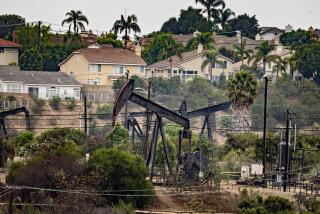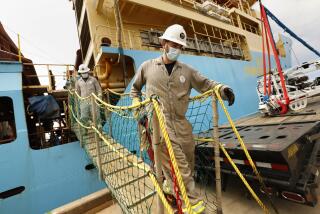Bradley Approves Palisades Drilling : Reverses Stand on Bitterly Contested Oil Proposal for Fragile Coastline
- Share via
In a stunning reversal of past policy, Los Angeles Mayor Tom Bradley announced Saturday his approval of Occidental Petroleum Corp.’s bitterly contested proposal to drill for oil along the city’s fragile coastline in Pacific Palisades.
Bradley’s decision, which he described as one of the most agonizing he has made as mayor, climaxed a nearly 20-year-long environmental battle between Occidental and its City Hall opponents, who were once led by Bradley.
The last time the issue came before him, in 1978, the mayor vetoed the project, and Occidental’s foes expected Bradley to do the same thing again. However, Bradley said Saturday that Occidental had convinced him that it could do the job without jeopardizing the landscape or marring its beauty.
‘Simply Not Enough’ “It was simply not enough to reject the proposal this time because I had done so in the past,” Bradley said. “My decision was based on information provided today, not on yesterday’s facts.
“After prolonged soul-searching and a thorough examination of the facts, I am persuaded to concur with the two-thirds majority in the City Council who voted for the applicant,” Bradley said in reference to the council’s 10-4 vote last week.
The mayor, who has just begun a campaign for reelection, conceded that his decision, which was opposed by key members of his staff, including Deputy Mayor Tom Houston, might not be a popular one.
“I know that with some this may not be a popular political decision, but I have never made a decision which impacts this city based on its popularity,” he said, after signing an ordinance approving the application.
The Pacific Palisades area is part of the city’s 11th Council District, which has already been targeted by Bradley’s more conservative opponent, Councilman John Ferraro, because the area tends to be more conservative than the rest of the city.
Bradley’s opposition to Occidental was a highlight of his first successful campaign for mayor in 1973. He has carried the 11th District in every race, but now that he has changed his position on that crucial issue, his hopes of winning the district again may have dimmed.
Foes of the project, including Assemblyman Gray Davis and City mayoral Councilman Marvin Braude, who represent Pacific Palisades, denounced Bradley’s decision.
Davis said the mayor was “taunting Mother Nature” by allowing drilling to take place in an area prone to landslides.
And Davis and Braude warned that granting permission to Occidental might open the way for offshore drilling in Santa Monica Bay.
Davis and other officials, including Rep. Mel Levine (D-Los Angeles), believe it will be difficult for members of Congress to renew a one-year ban on the sale by the federal government of oil leases in the bay once the city has authorized drilling on the shore.
“By allowing Occidental to start drilling within a few hundred yards of the water, the city may well have sealed the fate of Santa Monica Bay,” Davis said.
“Now that the city has accepted the environmental degradation that accompanies oil drilling on the shore, it will be very difficult to credibly oppose the oil drilling that is proposed in federal waters.”
Federal waters begin three miles offshore. Closer to the shore, the bay is under the jurisdiction of the state, which has imposed an indefinite moratorium on oil drilling.
That ban, too, will be in jeopardy, Davis said, as a result of the city’s action.
Even Bradley’s deputy, Houston, said in November that the federal moratorium would be harder to maintain if the city approved the Occidental project.
Bradley, who has opposed drilling in the bay, said Saturday that his decision “does not open the door to rampant oil drilling along our shoreline or in the Santa Monica Bay.”
He added that “the drilling in the Palisades will not in any way negate our continued and vehement opposition to offshore drilling in the Santa Monica Bay and in other areas.”
Oil Officials Jubilant Officials of Occidental, who spent close to $50,000 in an intensive City Hall lobbying campaign, reacted jubilantly to the mayor’s announcement.
“This represents 20 years of work and we think it will prove beneficial to the city,” said Frank Ashley, the company’s director of communications. “We want to assure people in the Palisades and anyone else concerned that this project will in no way impact Santa Monica Bay.”
Occidental’s struggle, however, is not over. The company now must win approval from the California Coastal Commission and, perhaps, face a court challenge now being threatened by angry Pacific Palisades residents.
The drill site, across the Pacific Coast Highway from Will Rogers State Beach, would be located a few hundred yards from the ocean on the edge of the bay. Occidental officials have said they believe that the strata beneath the site hold up to 60 million barrels of oil, which they say is a significant domestic deposit.
Bradley said he changed his mind because Occidental, with the help of new technology, now would be able to protect the surrounding environment, in particular the adjacent hillside where landslides have occurred in the past.
The mayor indicated that the key to Occidental’s current drilling application is an offer to build a drainage system designed to stabilize the slopes above the drill site. Until last year, the oil company had rejected the idea of a drainage system, saying it would be of uncertain value.
Said Bradley: “Technical experts have testified that such a system, installed and maintained to the standards of the Department of Building and Safety and the Bureau of Engineering, would render the bluff more stable with the drilling permitted than if left in its present unstable condition.”
The system, according to Occidental, would be composed of a number of horizontally inserted drainage pipes designed to siphon thousands of gallons of water from the moisture-laden slopes.
City Indemnified In explaining his approval of the project, Bradley also cited an agreement by Occidental to indemnify the city against any damages attributable to Occidental’s operations. He said the oil company will be able to camouflage its drill site, muffle drilling noise and, generally, prevent the operation from blighting the landscape.
“Those factors,” Bradley said, “ensure that the drilling for oil in the Palisades will take place in much the same manner as oil drilled in other areas of the city such as Venice, parks, commercial and residential areas.”
Bradley said it would not be fair to Occidental to deny it permission to drill for oil while the city allows other companies to drill in many areas of the city, including at beaches.
Bradley’s decision appeared to come as a surprise to some of the people closest to him.
“I certainly would have done the opposite thing,” said Deputy Mayor Houston. “You win some and you lose some.”
While Houston and other top advisers, notably Frances Savitch, a longtime aide, and Maureen Kindell, president of the Board of Public Works, have said they were opposed to the Occidental project, others who work closely with the mayor, such as Council President Pat Russell and Councilman David Cunningham, favored the project. Russell, like Bradley, had opposed it in 1978.
As the issue made its way through the City Council last fall, there was speculation at City Hall that Occidental President Armand Hammer’s close association with the city in recent months could influence the mayor’s decision.
On Saturday, Bradley enumerated Hammer’s contributions to the city, but he insisted that neither they nor Occidental’s financial contributions to city officials had anything to do with the decision on the oil drilling project.
More to Read
Sign up for Essential California
The most important California stories and recommendations in your inbox every morning.
You may occasionally receive promotional content from the Los Angeles Times.









